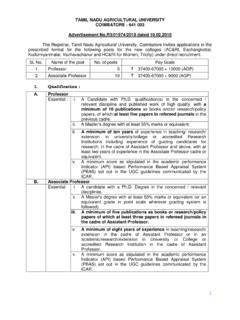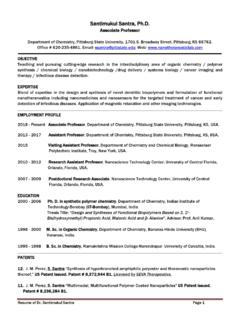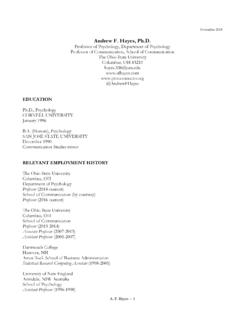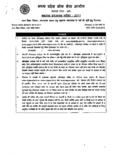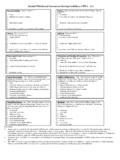Transcription of The Use of Big Data Analytics by the IRS: Efficient ...
1 817 The Use of Big Data Analytics by the IRS: Efficient Solutions or the End of Privacy as We Know It? Kimberly A. Houser* and Debra Sanders** ABSTRACT This Article examines the privacy issues resulting from the IRS s big data Analytics program as well as the potential violations of federal law. Although historically, the IRS chose tax returns to audit based on internal mathematical mistakes or mismatches with third party reports (such as W-2s), the IRS is now engaging in data mining of public and commercial data pools (including social media) and creating highly detailed profiles of taxpayers upon which to run data Analytics .
2 This Article argues that current IRS practices, mostly unknown to the general public are violating fair information practices. This lack of transparency and accountability not only violates federal law regarding the government s data collection activities and use of predictive algorithms, but may also result in discrimination. While the potential efficiencies that big data Analytics provides may appear to be * Washington State University Pullman, Clinical Associate Professor of Business Law, 509-335-7385. ** Washington State University Vancouver, Professor of Accounting. Authors thank the hosts of the 2016 Law and Ethics of Big Data Research Colloquium in Bloomington, Indiana; the Center for Business Intelligence and Analytics , Pamplin College of Business, Virginia Tech, and the Department of Legal Studies, Kelley College of Business, Indiana University.
3 Authors particularly thank the participants in the colloquium for their helpful comments: John Bagby, Solon Barocas, Jody Blanke, Deven Desai, Janine Hiller, Dennis Hirsch, Peter Hook, Margaret Hu, Nancy King, David Nersessian, Nizan Geslevich Packin, Abbey Stemler, and Emma Young. 818 VAND. J. ENT. & TECH. L. [Vol. XIX:4:817 a panacea for the IRS s budget woes, unchecked, these activities are a significant threat to privacy. Other concerns regarding the IRS s entr e into big data are raised including the potential for political targeting, data breaches, and the misuse of such information. This Article intends to bring attention to these privacy concerns and contribute to the academic and policy discussions about the risks presented by the IRS s data collection, mining and Analytics activities.]
4 TABLE OF CONTENTS I. INTRODUCTION .. 819 II. THE IRS .. 820 A. IRS Data Collection .. 821 1. Phone Records .. 822 2. Emails .. 823 3. Social Media .. 823 4. Data Mining .. 824 B. History of Improper Audits .. 825 C. Audit Selection History .. 828 III. POTENTIAL LEGAL ISSUES .. 834 A. Fair Information Practices .. 834 1. No Notice .. 835 2. No Secret Data Collection Systems .. 836 3. No Consent for Third Party Contact .. 838 4. Loss of Control over Use of Personal Information .. 838 B. Lack of Transparency in Algorithm .. 842 1. Violations of Administrative Procedure Act .. 843 2. Lack of Accuracy of Big Data .. 845 3. Potential Discrimination .. 848 4. Arbitrary and Capricious Agency Action.
5 850 C. Data Collection .. 851 1. Electronic Communications Privacy Act .. 852 2. Warrantless Search .. 854 3. Due Process .. 856 4. Self-Incrimination .. 857 D. Other Federal Violations .. 858 1. Privacy Act of 1974 .. 858 2. Computer Matching and Privacy Protection Act .. 860 3. Internal Revenue Code Section 6013 .. 863 4. Data Quality Act .. 864 IV. POTENTIAL MISUSE OF DATA AND ALGORITHM BY IRS .. 866 A. Data Breach .. 866 B. Misuse of Information and Targeting by Government .. 868 2017] BIG DATA Analytics : THE END OF PRIVACY? 819 C. Surveillance by Government (Big Brother) .. 869 V. CONCLUSION .. 870 I. INTRODUCTION Although tax evasion cost the US government over $3 trillion during the first decade of the 2000s,1 the Internal Revenue Service (IRS) budget was cut 17% and employees were reduced by 14% in At the same time, there has been a 7% increase in tax returns filed as well as the passage of two statutes increasing the IRS s workload: the Implement Foreign Account Tax Compliance Act and the Patient Protection and Affordable Care In response, the Office of Compliance Analytics was created in 2011 as a new division of the IRS.
6 The office is charged with developing an advanced Analytics program, relying on the use of big data and predictive algorithms to reduce tax fraud. According to Jeff Butler, the Associate Director of Data Management at the IRS Research, Analysis, and Statistics Organization: The IRS uses a wide range of analytic methods, tools, and technologies to address such problems as ID theft, refund fraud, inventory optimization, and other activities related to its statutory mandates. In an era of persistently reduced budgets, the use of data Analytics has become more important than ever to drive innovation, risk management, and decision making across the The IRS uses big data Analytics to mine commercial and public data pools including social media sites ( , Facebook, Instagram, and Twitter).
7 5 This data is then added to its proprietary data bases, and 1. Federal Revenue Lost to Tax Evasion, DEMOS, [ ] (last visited Apr. 9, 2017). 2. Chuck Marr & Cecile Murray, IRS Funding Cuts Compromise Taxpayer Service and Weaken Enforcement, CTR. ON BUDGET & POL Y PRIORITIES (Apr. 4, 2016), [ ]. 3. Id. 4. Sean Robinson, Wise Practitioner Predictive Analytics Interview Series: Jeff Butler at IRS Research, Analysis, and Statistics Organization, PREDICTIVE Analytics TIMES (Sept. 2, 2015), -interview-series-jeff-butler-at-irs-res earch-analysis-and-statistics-organizati on09022015/6243/ [ ]. 5. Dara Kerr, Tax Dodgers Beware: IRS Could Be Watching Your Social Media, CNET (Apr.)
8 15, 2014), -media/ [ ]; see also Tim Sampson, FYI, the IRS Is Looking at Your Online Activity for Signs of Tax Evasion, DAILY DOT (Apr. 16, 2014), [ ]; Report: IRS Data Mining Facebook, Twitter, Instagram and Other Social Media Sites, CBSDC 820 VAND. J. ENT. & TECH. L. [Vol. XIX:4:817 pattern recognition algorithms are run to identify potential noncompliant Data Analytics has proven to be a useful tool in successfully identifying fraud victims, and, according to the IRS, computer identification of noncompliant taxpayers is less subjective than other However, the IRS is less forthcoming about its use of data Analytics in deciding whom to audit.]
9 The decision is based on private, highly detailed profiles of each US taxpayer, created from sources other than the taxpayer s returns and third party Also, the question remains as to whether the data upon which algorithms rely is accurate and if the algorithms themselves may result in discrimination. Overall, the collection and use of this data without proper oversight and the increasing reliance on machine generated decisions may result in harm. This Article will explore a number of potential issues pertaining to the IRS s use of big data and predictive algorithms. Part II explains data collection by the IRS, the history of improper audits, and how the IRS selects returns for audit.
10 Part III outlines the legal issues raised by the IRS s data collection activities and their use of predictive Analytics . Part IV discusses the potential for misuse of data and algorithms by the IRS. Part V provides the conclusion. II. THE IRS The IRS is the branch of the United States Department of Treasury that is responsible for administering the Internal Revenue Code and enforcing tax Income taxes were introduced to the United States in 1913 when the Sixteenth Amendment was While the Treasury Department collects the taxes, the IRS is responsible for examining the tax returns for accuracy and bringing criminal action against those who file incorrect Each tax return is checked internally for mathematical accuracy and consistency, regardless of whether it is submitted via mail or (Apr.)
